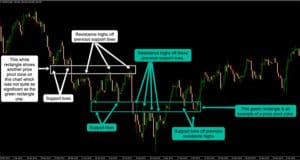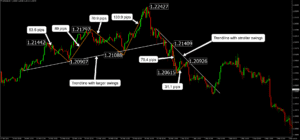When trading or investing, it’s easy to get caught up in focusing on the best entries and exits without paying much attention to risk management. Any consistently profitable trader or investor will likely tell you that risk management is more important than your entry strategy. After reading this, you’ll learn about essential risk management tips you must know about that will help protect your account.
I’ll first explain the basics of position sizing in forex with examples and then explain essential tips for risk management by going through the four types of forex position-sizing calculations you must know about.
Position sizing is the number of units or lots used to trade a stock, a foreign exchange pair, or any other market. Often the term used for shares is units, and the term in forex is called lots.
You can have the best trading strategy, but if your position-sizing is consistently too large or too small, you won’t have good results. First and foremost, investors and traders are risk managers, so you should be able to do position size calculations quickly before risking money.
How to position size for forex

I’ll show a few examples to get a good idea. Before we move to the calculations, here’s a list of things you’ll need to be able to position size correctly.
Also, consider the opportunity cost of position-sizing so that you don’t miss out on a better trade because they risked too much for a weaker trade. Another thing to consider when position-sizing is if you want to use a fixed percentage amount per trade. Be aware that by using a fixed amount you won’t be able to compound your account over that period.
1. Account denomination the same as the counter currency
Now I’ll introduce you to newbie Nick, who has already blown an account and is looking to stop hitting and hoping with his trades.
Let’s say newbie Nick is trading the GBP versus USD and wants to trade with 100 pips as the distance between his entry and stop-loss. His account size is $50,000, and he wants to risk 1% of his account on this trade.
First, Nick can do $50,000 times 1%, which is $500 risk.
Next, he can divide $500 by 100 pips which is $5 per pip risk.
Lastly, multiply the risk per pip ($5) by the unit value and divide this by the pip value per lot of GBP versus USD.
In the forex market, 1 standard lot for most cases is equal to $10 per pip. 1 standard lot is equivalent to 100,000 units.
If Nick does the lot unit value, which is 100,000 units, and he divides this by the pip value per lot, which is $10, he gets 10,000.
Nick’s risk per pip was $5 per pip; therefore, if Nick multiplies $5 by 10,000, he gets 50,000 units. 50,000 units is the same as 0.5 standard lots because 1 standard lot, as mentioned earlier, is 100,000 units.
The result is that Nick’s position size for this trade should be 0.5 standard lots.
2. Account denomination the same as the base currency
 Let’s now look at an example of position-sizing when Nick’s account currency differs from the counter currency for the currency pair he’s trading. The counter currency is the second currency appearing in a currency pair quotation, and it’s also sometimes called the quote currency.
Let’s now look at an example of position-sizing when Nick’s account currency differs from the counter currency for the currency pair he’s trading. The counter currency is the second currency appearing in a currency pair quotation, and it’s also sometimes called the quote currency.
This example is if the account denomination is the same as the base currency. The base currency is the first currency for any currency quote. In the example, Nick’s account is in USD, and the market he was trading was GBP/USD; therefore, the base currency was the same.
Let’s use an example if Nick decides to move to Britain because he loves drinking tea while eating cream scones. His account is now in pounds instead of US dollars, so his risk would be £50,000 multiplied by the 1% he wants to risk, which is £500.
Now, all we have to do is find out this risk in the base currency, which is USD if Nick is trading GBP/USD.
Let’s say the rate for GBP/USD was 1.4; therefore, we multiply £500 by 1.4. This gives $700 risk, so we then follow the same steps as earlier.
We do $700 risk divided by 100 pips which gives $7 per pip risk.
If Nick now multiplies his risk per pip ($7) by 10,000 units, he gets 70,000 units (equal to 0.7 standard lots).
Nick should now risk 0.7 lots if he wants to use 500 euros risk for his trade.
To recap, in the first example, we had the account denomination the same as the counter currency. In the second example, the account denomination was the same as the base currency.
These two calculation examples are simple enough. However, it gets a bit more complicated when we want to trade with account denominations different from the currency pair we are trading for both the base and counter currencies.
Don’t worry though; we’ll go through these last two types of calculations step by step with examples.
3. Account denomination is not in the currency pair traded, but it’s the same as the conversion pair’s counter currency
First, let’s look at an example where the account denomination is not in the currency pair traded, but it’s the same as the conversion pair’s counter currency.
In this example, Nick decides he’s tired of tea and scones and wants to return to the US for some classic American apple pie, so his account is now in USD. He trades the euro versus the pound with a 400 pip stop-loss.
To find the correct position size, we need to find the value of Nick’s risk in British pounds.
Nick wants to risk 1% of his $50,000 account for a 400 pip position on the euro versus the pound.
1% is $500, and if we multiply this by the GBP/USD rate, which was 1.4, then we need to invert that exchange rate to find the right amount of pounds to risk.
Therefore, we do 1 divided by 1.4, which is 0.71, and then multiply 0.71 by $500, which gives £357. So Nick’s risk for this trade is £357, and now we finish the rest like in the earlier examples.
Divide the £357 risk by the 100 pip stop-loss for £3.57 per pip.
Then we do £3.57 multiplied by the unit-to-pip value, which is 10,000 units divided by £1 per pip, which is 10,000.
This answers 35,700 units which can be rounded up to 0.36 lots.
4. Account denomination is not in the currency pair traded, but it’s the same as the conversion pair’s base currency

Let’s see how to calculate the position size if the account denomination is not in the currency pair traded, but it’s the same as the conversion pair’s base currency. Remember, the base currency is the first currency in a currency pair.
Nick ate way too many American apple pies, and his wife wasn’t pleased with that!
He decides to move to Switzerland to go skiing to try to burn off some of those apple pie calories. Nick’s account denomination is now in Swiss Francs (CHF), and before hitting another ski run, he decides to trade the USD versus JPY.
Feeling the adrenaline from his skiing adventures, he risks 3% of his 50,000 CHF account. His risk is 1500 CHF, and his stop-loss is 200 pips away this time.
First, we need to find the value of CHF in Japanese Yen (JPY), so we need the exchange rate for CHF/JPY, which let’s say was 110.
Since Nick’s account is in the same currency as the conversion pair’s base currency, we can use the 110 CHF/JPY exchange rate without finding the invert. So, it’s 1500 CHF multiplied by 110 equals 165,000 JPY.
Now we finish it like how we did all the other examples.
We do 165,000 JPY divided by 200 pips which is 825 JPY per pip.
Next, we do 825 JPY multiplied by the unit-to-pip value, which is 100 units of USD/JPY divided by 1 JPY per pip.
This gives 82,500 units which is equal to 0.825 standard lots.
Nick finally has had enough of skiing and trading – he wants to relax after all the hard work.
You may have noticed the pip value calculations were different in the last step where we had to calculate the unit-to-pip value. This is because the pip value is different for currency pairs where the counter or quote currency, the last currency in a pair, is different.
For example, with pairs like euro versus USD or GBP versus USD, where USD is the counter currency, the value of a pip stays the same. For USD as the counter currency, the pip value is equal to $10 per pip if the lot size is 1 standard lot or 100,000 units.
To calculate the pip value, divide 1 pip by the current market value of the forex pair. Then multiply that figure by the lot size. This means the value of a pip will vary as the variations in exchange rates change.
You don’t need to worry about calculating pip values, your broker will do it for you, or you can find pip value calculators online. Also, you don’t need to worry about calculating position sizes as this can also be done by online position-sizing calculators. You must familiarise yourself with the process to have a good idea of what’s happening with these calculations. By being aware of what calculations are going on, you can see if your position-sizing from the calculators are way off the correct amount.
Also, by doing these calculations, you’ll easily learn how to do position-sizing for stocks and most other markets.
Position-sizing can seem quite complex for beginners, so practice a few examples of each of the four calculations; then you’ll get the hang of it and find it more straightforward.
Use a free online position size calculator to check if your calculations are correct.
Summary
Here are the four different types of position sizing calculations:
- Account denomination is the same as the base currency.
- Account denomination is the same as the counter currency.
- Account denomination is not in the currency pair traded, but it’s the same as the conversion pair’s counter currency.
- Account denomination is not in currency pair traded, but it’s the same as the conversion pair’s base currency.
By understanding these four calculations, you will have an advanced understanding of position-sizing. If you learned something new or just want to meet Nick again, consider checking out the related articles below.






